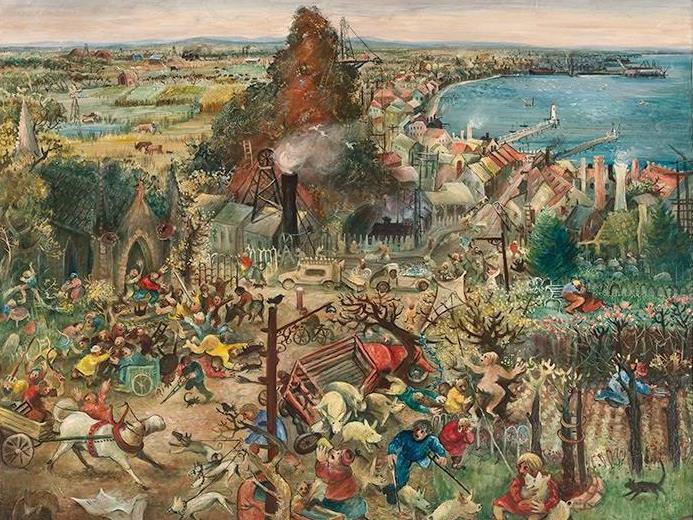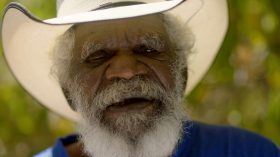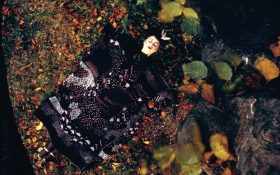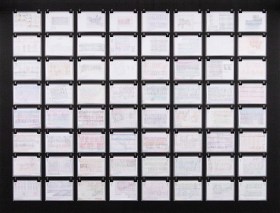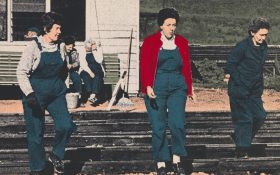Arthur Boyd ‘The mining town (Casting the money lenders from the temple)’ c.1946, oil and tempera on composition board, 87.4 x 109.4 cm, National Gallery of Australia, Canberra, purchased 1974.
Arthur Boyd could hardly have been an accountant, given his illustrious family tree. A small room in this exhibition is dedicated to its sprawling branches, which form what is perhaps Australia’s only artistic dynasty. Arthur Boyd’s grandparents, Arthur Merric Boyd and Emma Minnie a Beckett, were both painters; his father Merric Boyd, a studio potter; his uncle, Martin Boyd, an acclaimed writer; his brothers, David and Guy Boyd, both artists of the painting and sculpting variety; his sister Mary, a ceramicist and painter who went on to become the wife of John Perceval and Sidney Nolan.
Spanning three decades and encompassing etchings, paintings, ceramic sculpture, tapestries, pastel drawings, and costume and set design, Agony and Ecstasy is largely the result of Arthur and Yvonne Boyd’s generous gift of several thousand works in 1975 to the National Gallery, then in its nascent stages. Curator Deborah Hart is at pains to emphasise that this is not a retrospective. Rather, it is a thematic exhibition, revealing Boyd’s engagement with the humanist tradition in Western art stretching from the Renaissance to the present. As this exhibition makes apparent, Boyd’s best works are a visceral exploration of the human condition and all the bliss and misery that this entails.
The first room of the exhibition is testament to the young Arthur Boyd’s expansive frame of cultural reference, which was coupled with frenetic formal experimentation. Boyd’s earliest canvasses are impressionistic rural scenes apparently rendered en plein air, featuring a neutral palette and plentiful square brushstrokes. These works are simple and pretty, which could not be safely said of anything he has painted since.
The Second World War – in which Boyd was conscripted as a member of the cartographic unit but never saw active service – formed the impetus for his creation of stark figurative works that convey a deeply dystopian vision of wartime society. In works such as Lovers on a Bench (1943), personal relationships are corrupted by military conflict. A shell-shocked solider is coercively embraced by a prostitute, their squat, distorted figures scarcely accommodated by the picture’s frame. In the background, the ‘dark satanic mills’ that sustain the war effort chug away.
One of the most compelling works on show is The mining town (casting the money lenders out of the temple) (c. 1946), based on the allegorical masterpieces of Flemish Renaissance painter Pieter Bruegel the Elder (1529-1569). Boyd closely emulates the techniques of medieval and Renaissance masters in his use of tempera and a vertically layered composition, eschewing single point perspective. Boyd’s sprawling canvas presents a catalogue of sin: beyond the violent eviction of the money lenders we see a man cruelly whipping his horse, another attempting to steal a pig, and two lovers openly copulating on a park bench – all against a backdrop of environmental destruction.
The following rooms contain works from three of Boyd’s most celebrated sequences – the Bride, the Nebuchadnezzar and the Caged Artist series. It is here that the exhibition’s flamboyant title comes into its own. Boyd’s Nude falling into a river (1962) is a Chagallian floating bride, though more morbid than whimsical. The gritty painterly texture of the nude figure gives way to the silky, rippling depths in which she is suspended. A sense of incongruity pervades this work: there is a calmness in the bride’s self-annihilation as the water threatens to take the life it once helped sustain.
In the Caged Artist works, the dissonances are all the more intense as Boyd grapples with the triumphs and drudgery of artistic endeavour. In Kneeling figure with canvas and black can (1973), the artist is a prisoner of his own creativity. Amid the blazing heat of an Australian summer, the tortured artist bends over a canvas and a pot of paint. A cat o’ nine tails lies at his feet, while a muzzled beast grasps his back. The artist’s sensitivities, his impulses, his talents, are all oppressive – they force him to suffer the plight of human existence too keenly.
This show marks a substantial contribution to the historiography of Arthur Boyd, if only because it features several works never before exhibited – notably the salvaged fresco, The Prodigal Son (1948-9). The versatility of Boyd’s creative practice as revealed in this exhibition is astounding, and would have presented a formidable challenge to any curator. Without the curatorial discipline of Deborah Hart this show could easily have resembled a yard sale, but it has been brilliantly executed.
As an observer of the human condition, Arthur Boyd’s gaze is utterly unflinching. This can make for some profoundly disquieting visual encounters, but to quote V.S. Naipaul, ‘the world is what it is.’
Rating: 4 out of 5
Arthur Boyd: Agony and Ecstasy
National Gallery of Australia
Parkes Places, Parkes, ACT
Admission: $15 adults, $12 concession, $10 NGA members
5 September – 9 November 2014
